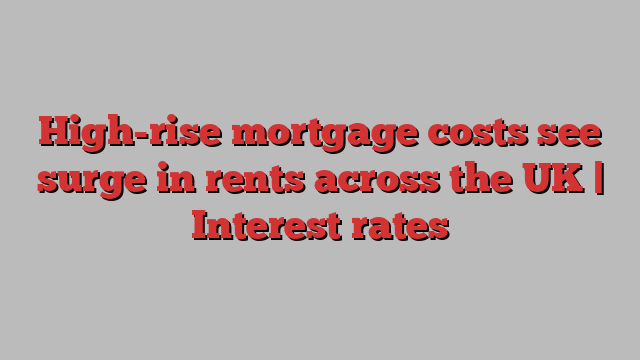
It’s a tale of two markets: while private rents have soared to record highs in the UK, making life precarious for tenants, the for-sale sector has slowed sharply and property values have started to fall, with sharper declines predicted for next year.
The latest house price index from Nationwide, Britain’s biggest building society, along with Bank of England mortgage lending data due this week, should shed further light on the severity of the UK’s housing slowdown.
The market was cooling, and mortgage rates were creeping up, even before the Truss government’s disastrous mini-budget brought the pandemic-era housing boom to an abrupt halt.
Mortgage rates jumped to well above 6%, a level last seen in 2008, adding hundreds of pounds to mortgage payments and triggering a collapse in demand. Unsurprisingly, Nationwide figures for October showed the first monthly drop in house prices in 15 months: at 0.9%, it’s the largest fall since June 2020.
Expensive mortgages have deterred many first-time buyers, who are now renting instead in the hope that rates will fall in the new year – causing intensified competition in the rental market, according to property site Rightmove.
But that’s not the only explanation for the surge in rental costs. Tenants who work from home prefer, if they can afford it, to live alone rather than in a cramped house share, says Andrew Wishart of Capital Economics. The number of people renting a property alone rose by 530,000 in 2020-21, while the numbers renting in a household of three or more fell by 2 million.
Wishart suggests cost of living pressures could reverse this trend somewhat. “But with the average tenancy lasting four years, it won’t happen overnight,” he says, adding that buy-to-let landlords face a severe financial squeeze over the next few years and many could sell up, further reducing supply.
That shortage of rentals has, unsurprisingly, pushed up the amount tenants are prepared to pay. London estate agent Foxtons has reported a 22% year-on-year surge in rents in the capital in the first nine months of 2022. The average rent hit a new high of £571 a week – about £100 higher than at the beginning of the year.
Record numbers of new renters registered in the third quarter: there were 30 for every property listed, which is around three times recent levels. At the same time, supply has dwindled: new instructions from London landlords have fallen by 18% in the first nine months compared with a year ago.
Foxtons describes the conditions in London’s rental market as “extraordinary”, adding that “the impact of the post-Covid return to the city has been acute”.
Supply problems have been exacerbated by a rise in overseas student renters and corporate lets, and by 11% of landlords opting to sell their property at the end of a tenancy this year.
According to research published by Rightmove last month, advertised rents have jumped even more in some other cities and towns. These include Newbury, Manchester and Cardiff, which have all seen annual rises of close to 20% or more. Rents are expected to climb higher still next year, while house prices are set to head the other way, with many experts predicting declines of between 5% and 12%.
Capital Economics is forecasting that housing transactions will slump to their lowest level for a decade in 2023, and that the average house price will fall by 12%. Rightmove has estimated a smaller drop, of up to 5%, while property firm JLL is predicting a 6% decline.
Meanwhile interest rates are still on an upward track, with the Bank of England forecast to increase them by a further half point to 3.5% in mid-December. Rates are expected to peak at 4.25% next spring, which is lower than had once been feared.
“Even though mortgage rates are likely to drop back to 4% by 2024, we suspect that house prices will have to fall by 12% before affordability improves enough for demand to recover and the fall in prices to bottom out,” says Wishart.

